Operations Management, Continuous Improvement & Project Life Cycle
VerifiedAdded on 2023/06/08
|25
|5758
|252
Report
AI Summary
This report provides a comprehensive analysis of operations management principles and project lifecycle methodologies, focusing on their application within an organizational context, particularly Tesco. It begins by defining operations versus operations management, followed by a review and critique of the implementation of operations management principles, including Taylor's theory of scientific management. The report assesses how well Tesco's operations management meets its organizational requirements, emphasizing cost reduction, quality, and productivity. It delves into continuous improvement as a philosophy, describing Lean principles such as Kaizen and Just-in-Time, and proposes a continuous improvement plan with justified recommendations. Furthermore, the report examines the Project Life Cycle (PLC) stages, project methodologies, and tools, reviewing the effectiveness of PLC application using relevant theories and models, differentiating between large and small-scale projects.

Paraphrase This Document
Need a fresh take? Get an instant paraphrase of this document with our AI Paraphraser
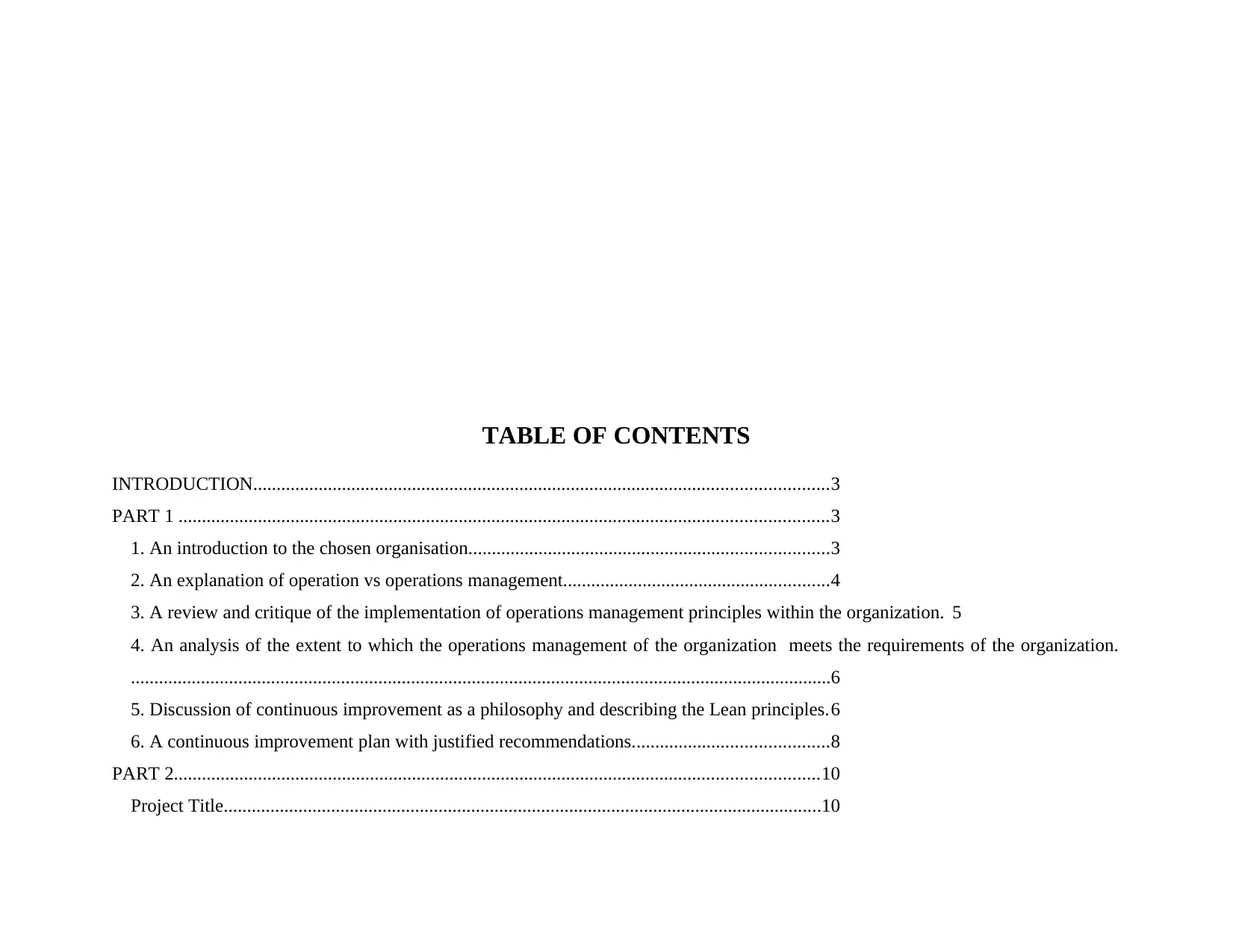
TABLE OF CONTENTS
INTRODUCTION...........................................................................................................................3
PART 1 ...........................................................................................................................................3
1. An introduction to the chosen organisation.............................................................................3
2. An explanation of operation vs operations management.........................................................4
3. A review and critique of the implementation of operations management principles within the organization. 5
4. An analysis of the extent to which the operations management of the organization meets the requirements of the organization.
......................................................................................................................................................6
5. Discussion of continuous improvement as a philosophy and describing the Lean principles.6
6. A continuous improvement plan with justified recommendations..........................................8
PART 2..........................................................................................................................................10
Project Title................................................................................................................................10
INTRODUCTION...........................................................................................................................3
PART 1 ...........................................................................................................................................3
1. An introduction to the chosen organisation.............................................................................3
2. An explanation of operation vs operations management.........................................................4
3. A review and critique of the implementation of operations management principles within the organization. 5
4. An analysis of the extent to which the operations management of the organization meets the requirements of the organization.
......................................................................................................................................................6
5. Discussion of continuous improvement as a philosophy and describing the Lean principles.6
6. A continuous improvement plan with justified recommendations..........................................8
PART 2..........................................................................................................................................10
Project Title................................................................................................................................10
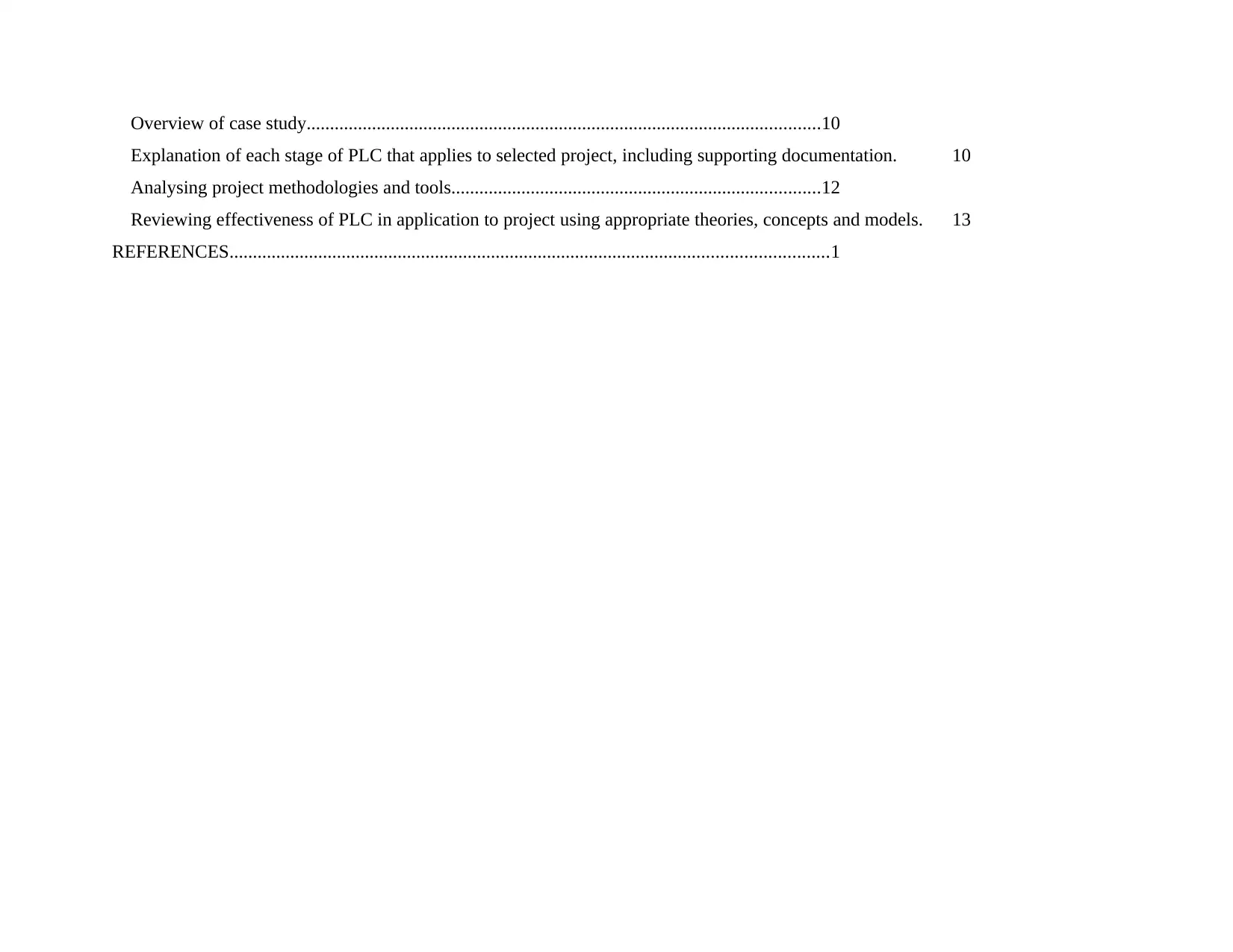
Overview of case study..............................................................................................................10
Explanation of each stage of PLC that applies to selected project, including supporting documentation. 10
Analysing project methodologies and tools...............................................................................12
Reviewing effectiveness of PLC in application to project using appropriate theories, concepts and models. 13
REFERENCES................................................................................................................................1
Explanation of each stage of PLC that applies to selected project, including supporting documentation. 10
Analysing project methodologies and tools...............................................................................12
Reviewing effectiveness of PLC in application to project using appropriate theories, concepts and models. 13
REFERENCES................................................................................................................................1
⊘ This is a preview!⊘
Do you want full access?
Subscribe today to unlock all pages.

Trusted by 1+ million students worldwide
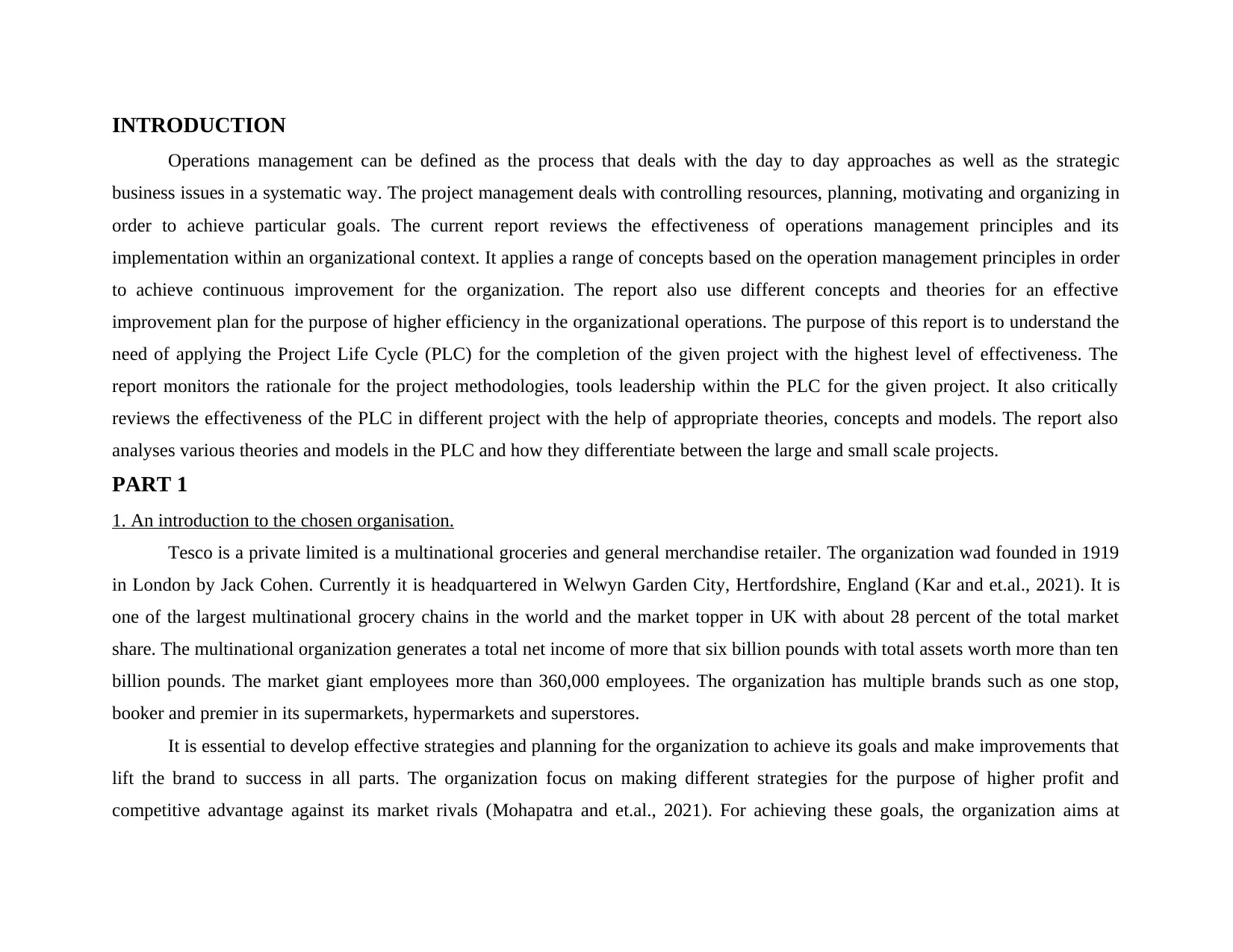
INTRODUCTION
Operations management can be defined as the process that deals with the day to day approaches as well as the strategic
business issues in a systematic way. The project management deals with controlling resources, planning, motivating and organizing in
order to achieve particular goals. The current report reviews the effectiveness of operations management principles and its
implementation within an organizational context. It applies a range of concepts based on the operation management principles in order
to achieve continuous improvement for the organization. The report also use different concepts and theories for an effective
improvement plan for the purpose of higher efficiency in the organizational operations. The purpose of this report is to understand the
need of applying the Project Life Cycle (PLC) for the completion of the given project with the highest level of effectiveness. The
report monitors the rationale for the project methodologies, tools leadership within the PLC for the given project. It also critically
reviews the effectiveness of the PLC in different project with the help of appropriate theories, concepts and models. The report also
analyses various theories and models in the PLC and how they differentiate between the large and small scale projects.
PART 1
1. An introduction to the chosen organisation.
Tesco is a private limited is a multinational groceries and general merchandise retailer. The organization wad founded in 1919
in London by Jack Cohen. Currently it is headquartered in Welwyn Garden City, Hertfordshire, England (Kar and et.al., 2021). It is
one of the largest multinational grocery chains in the world and the market topper in UK with about 28 percent of the total market
share. The multinational organization generates a total net income of more that six billion pounds with total assets worth more than ten
billion pounds. The market giant employees more than 360,000 employees. The organization has multiple brands such as one stop,
booker and premier in its supermarkets, hypermarkets and superstores.
It is essential to develop effective strategies and planning for the organization to achieve its goals and make improvements that
lift the brand to success in all parts. The organization focus on making different strategies for the purpose of higher profit and
competitive advantage against its market rivals (Mohapatra and et.al., 2021). For achieving these goals, the organization aims at
Operations management can be defined as the process that deals with the day to day approaches as well as the strategic
business issues in a systematic way. The project management deals with controlling resources, planning, motivating and organizing in
order to achieve particular goals. The current report reviews the effectiveness of operations management principles and its
implementation within an organizational context. It applies a range of concepts based on the operation management principles in order
to achieve continuous improvement for the organization. The report also use different concepts and theories for an effective
improvement plan for the purpose of higher efficiency in the organizational operations. The purpose of this report is to understand the
need of applying the Project Life Cycle (PLC) for the completion of the given project with the highest level of effectiveness. The
report monitors the rationale for the project methodologies, tools leadership within the PLC for the given project. It also critically
reviews the effectiveness of the PLC in different project with the help of appropriate theories, concepts and models. The report also
analyses various theories and models in the PLC and how they differentiate between the large and small scale projects.
PART 1
1. An introduction to the chosen organisation.
Tesco is a private limited is a multinational groceries and general merchandise retailer. The organization wad founded in 1919
in London by Jack Cohen. Currently it is headquartered in Welwyn Garden City, Hertfordshire, England (Kar and et.al., 2021). It is
one of the largest multinational grocery chains in the world and the market topper in UK with about 28 percent of the total market
share. The multinational organization generates a total net income of more that six billion pounds with total assets worth more than ten
billion pounds. The market giant employees more than 360,000 employees. The organization has multiple brands such as one stop,
booker and premier in its supermarkets, hypermarkets and superstores.
It is essential to develop effective strategies and planning for the organization to achieve its goals and make improvements that
lift the brand to success in all parts. The organization focus on making different strategies for the purpose of higher profit and
competitive advantage against its market rivals (Mohapatra and et.al., 2021). For achieving these goals, the organization aims at
Paraphrase This Document
Need a fresh take? Get an instant paraphrase of this document with our AI Paraphraser
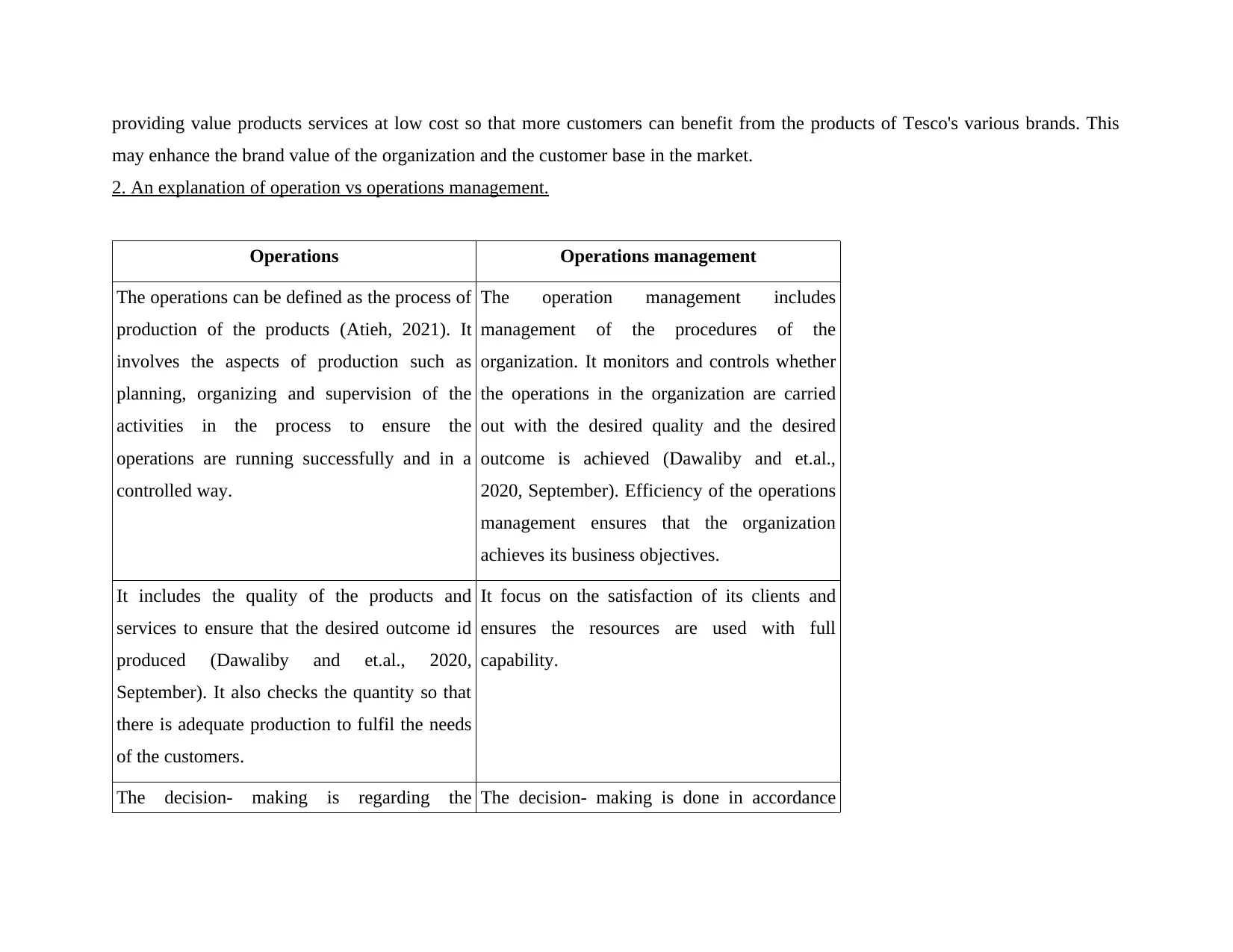
providing value products services at low cost so that more customers can benefit from the products of Tesco's various brands. This
may enhance the brand value of the organization and the customer base in the market.
2. An explanation of operation vs operations management.
Operations Operations management
The operations can be defined as the process of
production of the products (Atieh, 2021). It
involves the aspects of production such as
planning, organizing and supervision of the
activities in the process to ensure the
operations are running successfully and in a
controlled way.
The operation management includes
management of the procedures of the
organization. It monitors and controls whether
the operations in the organization are carried
out with the desired quality and the desired
outcome is achieved (Dawaliby and et.al.,
2020, September). Efficiency of the operations
management ensures that the organization
achieves its business objectives.
It includes the quality of the products and
services to ensure that the desired outcome id
produced (Dawaliby and et.al., 2020,
September). It also checks the quantity so that
there is adequate production to fulfil the needs
of the customers.
It focus on the satisfaction of its clients and
ensures the resources are used with full
capability.
The decision- making is regarding the The decision- making is done in accordance
may enhance the brand value of the organization and the customer base in the market.
2. An explanation of operation vs operations management.
Operations Operations management
The operations can be defined as the process of
production of the products (Atieh, 2021). It
involves the aspects of production such as
planning, organizing and supervision of the
activities in the process to ensure the
operations are running successfully and in a
controlled way.
The operation management includes
management of the procedures of the
organization. It monitors and controls whether
the operations in the organization are carried
out with the desired quality and the desired
outcome is achieved (Dawaliby and et.al.,
2020, September). Efficiency of the operations
management ensures that the organization
achieves its business objectives.
It includes the quality of the products and
services to ensure that the desired outcome id
produced (Dawaliby and et.al., 2020,
September). It also checks the quantity so that
there is adequate production to fulfil the needs
of the customers.
It focus on the satisfaction of its clients and
ensures the resources are used with full
capability.
The decision- making is regarding the The decision- making is done in accordance

production process of the business. The entire
process demands bigger investment as the
entire output is based on the operation of the
production.
with the activities in the business system. The
activities operations of different units impact
the management (Atieh, 2021). Compared to
the operations, it requires less investment as it
is generally dependent on the outcomes rather
than the end to end process.
In context of the organization, the operations ensures effectiveness, coordination and flexibility in the organization. Tesco may
evaluate whether the procedures are going as per the plan or not to ensure better productivity.
Tesco may use the operations management to ensure better working conditions as it is purposeful and considers group efforts.
It is tangible and in dispensable and hence, can be applied to different functions and at different levels.
3. A review and critique of the implementation of operations management principles within the organization.
Implementation of operations management principles is essential for the organization to achieve the maximum level of
effectiveness and efficiency in utilizing the resources of the company. In context of Tesco, the operations management process that
may be applied is the Taylor's theory of scientific management (Dar, 2022). The main principles and strengths of this theory are-
It advise the idea of replacing the traditional study work method by simple habits and common sense ideas of work and
perform the specific tasks with efficient and scientific methods.
The main strength of the theory is that it focus on assigning the work based on the capability and interests of the workers by
motivating them rather than simply assigning the work (Shann, 2021). Tesco may train its workers to make them capable for
performing specific tasks.
The organization monitors the employee performance and provide instructions and supervision to ensure effective work
methods are being used. It enables the organization to achieve higher efficiency in the operations.
process demands bigger investment as the
entire output is based on the operation of the
production.
with the activities in the business system. The
activities operations of different units impact
the management (Atieh, 2021). Compared to
the operations, it requires less investment as it
is generally dependent on the outcomes rather
than the end to end process.
In context of the organization, the operations ensures effectiveness, coordination and flexibility in the organization. Tesco may
evaluate whether the procedures are going as per the plan or not to ensure better productivity.
Tesco may use the operations management to ensure better working conditions as it is purposeful and considers group efforts.
It is tangible and in dispensable and hence, can be applied to different functions and at different levels.
3. A review and critique of the implementation of operations management principles within the organization.
Implementation of operations management principles is essential for the organization to achieve the maximum level of
effectiveness and efficiency in utilizing the resources of the company. In context of Tesco, the operations management process that
may be applied is the Taylor's theory of scientific management (Dar, 2022). The main principles and strengths of this theory are-
It advise the idea of replacing the traditional study work method by simple habits and common sense ideas of work and
perform the specific tasks with efficient and scientific methods.
The main strength of the theory is that it focus on assigning the work based on the capability and interests of the workers by
motivating them rather than simply assigning the work (Shann, 2021). Tesco may train its workers to make them capable for
performing specific tasks.
The organization monitors the employee performance and provide instructions and supervision to ensure effective work
methods are being used. It enables the organization to achieve higher efficiency in the operations.
⊘ This is a preview!⊘
Do you want full access?
Subscribe today to unlock all pages.

Trusted by 1+ million students worldwide

It distributes the work between the leaders and the employees so that they spent more time in their respective duties.
The implementation of the operations management principles within the organization ensures that the workers, leaders of
different functions are able to work with higher efficiency. This ultimately benefits the organization to achieve its goals.
Critiques-
Taylor's scientific management theory highlights the idea that there is only “one right way” to do something. It seeks push
decision- making through different organizational levels and pressure individual responsibility. Team work is where the Taylor's
theory fails as it tends to divide projects into smaller parts which is usually apposite to the modern methodologies (Dar, 2022). It
separates manual work from mental work and focus entirely on the mechanics, therefore, fails to value the employee side of work.
4. An analysis of the extent to which the operations management of the organization meets the requirements of the organization.
Operations management process is quite crucial as it manages the business of the organization in the most effective way. It
controls and supervise the various objectives of the firm.
Cost reduction- The management monitors the resources that are available in the organization, and they can be utilized in an
effective manner that it reduces the cost without compromising the quality (Turgut and et.al., 2022). It focus on the cost of operations
and productions and also on eradicating the unwanted cost to ensure proper production.
Quality of the products and services- The quality becomes the driving force that impact the decision- making of the
consumers. The operations management keep a check on the durability of the products and the reliability of the services and qualifies
the products that will best suit the customer's requirement.
Productivity- The operations management ensures that best employees are available along with the resources to achieve
maximum results and effective work process. It can be defined as an effective way to affirm the employees input.
In context of Tesco, the operation management contributes a lot in meeting the requirements of the organization. For example-
the quality of the goods of Tesco plays a big role in differentiating it with its competitors (Turgut and et.al., 2022). It has created a
The implementation of the operations management principles within the organization ensures that the workers, leaders of
different functions are able to work with higher efficiency. This ultimately benefits the organization to achieve its goals.
Critiques-
Taylor's scientific management theory highlights the idea that there is only “one right way” to do something. It seeks push
decision- making through different organizational levels and pressure individual responsibility. Team work is where the Taylor's
theory fails as it tends to divide projects into smaller parts which is usually apposite to the modern methodologies (Dar, 2022). It
separates manual work from mental work and focus entirely on the mechanics, therefore, fails to value the employee side of work.
4. An analysis of the extent to which the operations management of the organization meets the requirements of the organization.
Operations management process is quite crucial as it manages the business of the organization in the most effective way. It
controls and supervise the various objectives of the firm.
Cost reduction- The management monitors the resources that are available in the organization, and they can be utilized in an
effective manner that it reduces the cost without compromising the quality (Turgut and et.al., 2022). It focus on the cost of operations
and productions and also on eradicating the unwanted cost to ensure proper production.
Quality of the products and services- The quality becomes the driving force that impact the decision- making of the
consumers. The operations management keep a check on the durability of the products and the reliability of the services and qualifies
the products that will best suit the customer's requirement.
Productivity- The operations management ensures that best employees are available along with the resources to achieve
maximum results and effective work process. It can be defined as an effective way to affirm the employees input.
In context of Tesco, the operation management contributes a lot in meeting the requirements of the organization. For example-
the quality of the goods of Tesco plays a big role in differentiating it with its competitors (Turgut and et.al., 2022). It has created a
Paraphrase This Document
Need a fresh take? Get an instant paraphrase of this document with our AI Paraphraser
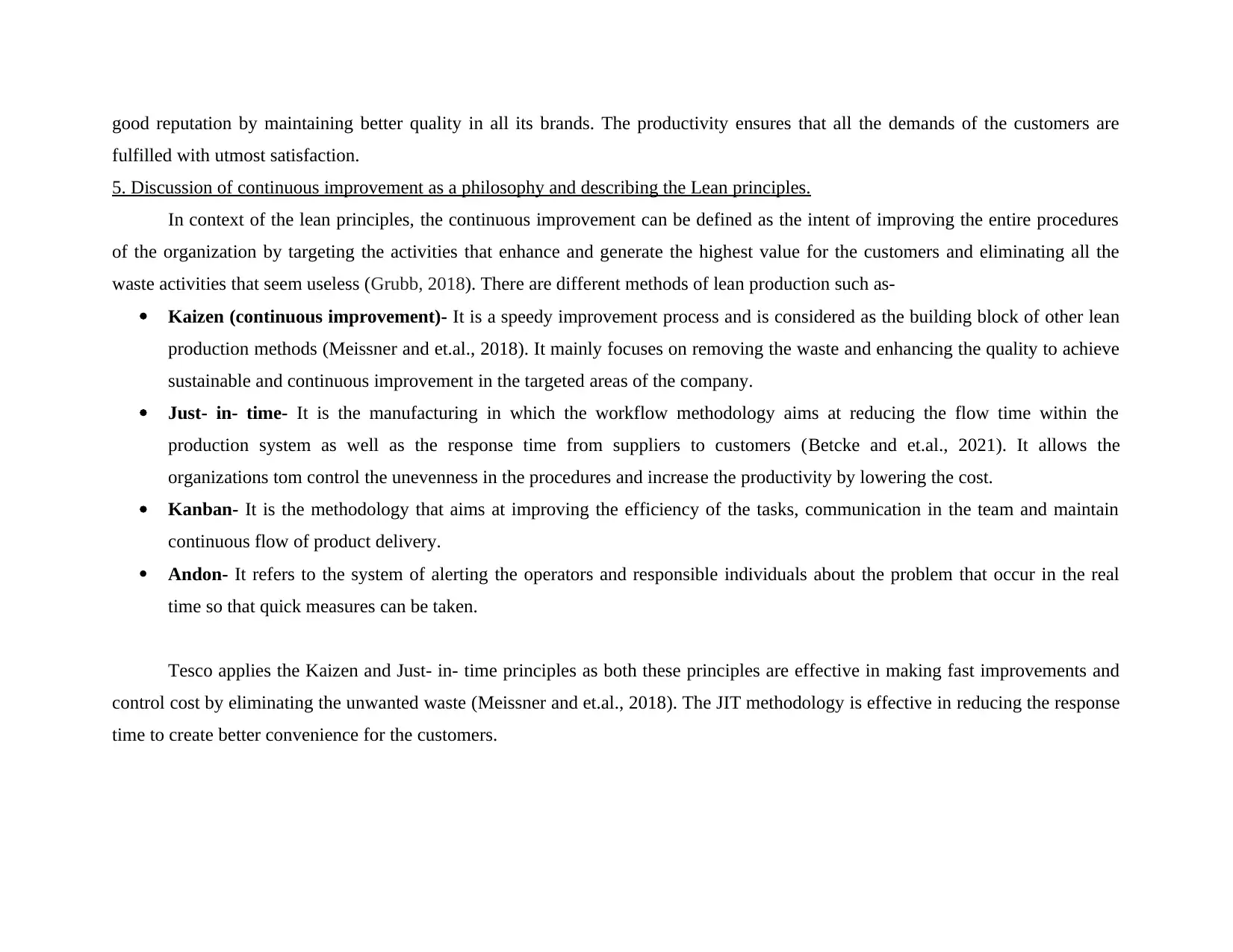
good reputation by maintaining better quality in all its brands. The productivity ensures that all the demands of the customers are
fulfilled with utmost satisfaction.
5. Discussion of continuous improvement as a philosophy and describing the Lean principles.
In context of the lean principles, the continuous improvement can be defined as the intent of improving the entire procedures
of the organization by targeting the activities that enhance and generate the highest value for the customers and eliminating all the
waste activities that seem useless (Grubb, 2018). There are different methods of lean production such as-
Kaizen (continuous improvement)- It is a speedy improvement process and is considered as the building block of other lean
production methods (Meissner and et.al., 2018). It mainly focuses on removing the waste and enhancing the quality to achieve
sustainable and continuous improvement in the targeted areas of the company.
Just- in- time- It is the manufacturing in which the workflow methodology aims at reducing the flow time within the
production system as well as the response time from suppliers to customers (Betcke and et.al., 2021). It allows the
organizations tom control the unevenness in the procedures and increase the productivity by lowering the cost.
Kanban- It is the methodology that aims at improving the efficiency of the tasks, communication in the team and maintain
continuous flow of product delivery.
Andon- It refers to the system of alerting the operators and responsible individuals about the problem that occur in the real
time so that quick measures can be taken.
Tesco applies the Kaizen and Just- in- time principles as both these principles are effective in making fast improvements and
control cost by eliminating the unwanted waste (Meissner and et.al., 2018). The JIT methodology is effective in reducing the response
time to create better convenience for the customers.
fulfilled with utmost satisfaction.
5. Discussion of continuous improvement as a philosophy and describing the Lean principles.
In context of the lean principles, the continuous improvement can be defined as the intent of improving the entire procedures
of the organization by targeting the activities that enhance and generate the highest value for the customers and eliminating all the
waste activities that seem useless (Grubb, 2018). There are different methods of lean production such as-
Kaizen (continuous improvement)- It is a speedy improvement process and is considered as the building block of other lean
production methods (Meissner and et.al., 2018). It mainly focuses on removing the waste and enhancing the quality to achieve
sustainable and continuous improvement in the targeted areas of the company.
Just- in- time- It is the manufacturing in which the workflow methodology aims at reducing the flow time within the
production system as well as the response time from suppliers to customers (Betcke and et.al., 2021). It allows the
organizations tom control the unevenness in the procedures and increase the productivity by lowering the cost.
Kanban- It is the methodology that aims at improving the efficiency of the tasks, communication in the team and maintain
continuous flow of product delivery.
Andon- It refers to the system of alerting the operators and responsible individuals about the problem that occur in the real
time so that quick measures can be taken.
Tesco applies the Kaizen and Just- in- time principles as both these principles are effective in making fast improvements and
control cost by eliminating the unwanted waste (Meissner and et.al., 2018). The JIT methodology is effective in reducing the response
time to create better convenience for the customers.

The six sigma is a data based improvement practice that organizations use in order to achieve strategic goals (Smętkowska and
et.al., 2018). In context of Tesco, six sigma is quite effective in
Defining the problems and task objectives.
Measuring the current data.
Analyzing the key findings and identifying the loopholes.
Improve the process on the basis of identified problems.
Controlling the procedures to avoid unevenness.
The continuous improvement plan for the organization-
Kaizen- It helps the organization in eliminating the unwanted additions in the process and reduce cost and time.
Quality circles- It is the group of employees that perform similar work and solve each- others work related issues regularly.
Bench- marking- It can be defined as the process of measuring the organization's performance bu comparing the products
with products of other organization (Grubb, 2018).
TQM- Total quality measurement is the focus of the business organization to maintain the internal quality of the organization
from the lowest level of workers to the highest executives.
SCM- Supply chain management handles the complete production flow of the goods and services.
ERP- Enterprise resource planning is a type of software that monitors and manage day to day business activities such as
accounts, operations etc.
With the help of this continuous business plan, the organization can eliminate the production cost, develop quality relations
between employees, identify the issues, measure the employee engagement, handle the production flow and monitor the entire plan to
achieve the best work flow possible (Jimoh and et.al., 2019).
et.al., 2018). In context of Tesco, six sigma is quite effective in
Defining the problems and task objectives.
Measuring the current data.
Analyzing the key findings and identifying the loopholes.
Improve the process on the basis of identified problems.
Controlling the procedures to avoid unevenness.
The continuous improvement plan for the organization-
Kaizen- It helps the organization in eliminating the unwanted additions in the process and reduce cost and time.
Quality circles- It is the group of employees that perform similar work and solve each- others work related issues regularly.
Bench- marking- It can be defined as the process of measuring the organization's performance bu comparing the products
with products of other organization (Grubb, 2018).
TQM- Total quality measurement is the focus of the business organization to maintain the internal quality of the organization
from the lowest level of workers to the highest executives.
SCM- Supply chain management handles the complete production flow of the goods and services.
ERP- Enterprise resource planning is a type of software that monitors and manage day to day business activities such as
accounts, operations etc.
With the help of this continuous business plan, the organization can eliminate the production cost, develop quality relations
between employees, identify the issues, measure the employee engagement, handle the production flow and monitor the entire plan to
achieve the best work flow possible (Jimoh and et.al., 2019).
⊘ This is a preview!⊘
Do you want full access?
Subscribe today to unlock all pages.

Trusted by 1+ million students worldwide

6. A continuous improvement plan with justified recommendations.
A continuous improvement plan is quite crucial for the organizations because the ever changing market dynamics demand the
latest trends and features in place (Jimoh and et.al., 2019). It also becomes an essential element in the competitive environment and
the improvement plans comes along with certain advantages and disadvantages.
Taylor's management plan-
Pros-
It enhances production and increases the organization's ability to control the system.
It reduce the cost of production and focus on quick decision- making.
Cons-
It requires high capital and the management takes the control.
It is too much bureaucratic and not suitable for teams.
It can be improved by using specialized techniques and regular monitoring of the workflow and identifying and working on the
issues that arise.
Flexible management specialization for improvement-
Pros-
It enhances the efficiency in the production process.
The production is mostly automated, reducing the labor cost.
Cons-
The built in cost is much higher and requires a lot of time in designing the system.
This can be improved by hiring specialized employees that can utilized the automated techniques in the best manner.
A continuous improvement plan is quite crucial for the organizations because the ever changing market dynamics demand the
latest trends and features in place (Jimoh and et.al., 2019). It also becomes an essential element in the competitive environment and
the improvement plans comes along with certain advantages and disadvantages.
Taylor's management plan-
Pros-
It enhances production and increases the organization's ability to control the system.
It reduce the cost of production and focus on quick decision- making.
Cons-
It requires high capital and the management takes the control.
It is too much bureaucratic and not suitable for teams.
It can be improved by using specialized techniques and regular monitoring of the workflow and identifying and working on the
issues that arise.
Flexible management specialization for improvement-
Pros-
It enhances the efficiency in the production process.
The production is mostly automated, reducing the labor cost.
Cons-
The built in cost is much higher and requires a lot of time in designing the system.
This can be improved by hiring specialized employees that can utilized the automated techniques in the best manner.
Paraphrase This Document
Need a fresh take? Get an instant paraphrase of this document with our AI Paraphraser

Kaizen's improvement plan-
Pros-
It focus on strengthening the teamwork and improve the leadership skills.
It benefits the employees as well as the customers.
Cons-
Implementing bigger changes becomes complicated.
Additional training becomes essential.
This can be improved by proper training and a system that takes care of individual interests. It also requires detailed planning
to make sure all aspects are covered.
Pros-
It focus on strengthening the teamwork and improve the leadership skills.
It benefits the employees as well as the customers.
Cons-
Implementing bigger changes becomes complicated.
Additional training becomes essential.
This can be improved by proper training and a system that takes care of individual interests. It also requires detailed planning
to make sure all aspects are covered.

PART 2
Project Title
In house, is the main title of current project, that drives the attention of project manager toward conducting strategic and
essential practices.
Overview of case study.
In the Midlands, organization is performing well, with 1250 candidates, who are capable to fulfil their duties and
responsibilities in appropriate manner. In the premise, employees are unable to eat their meal on-site, because of no on-site catering
facility that they expect to obtain. It is quite essential for a project officer, while working in the project & programme office as a team
member, who is accountable to deliver change programme for the company. In house project encompasses two different business
objectives and these are;
To reduce movement of staff from premises during lunch break, which is recently developing congestion problems in the local
area.
To support employees, for purpose of developing a healthy lifestyle which company believes is part of their corporate social
responsibility and reduce employees absenteeism.
The main motive of this project is to cook or prepare food in house, which is healthy and budget friendly, too, so that
employees can afford the same. It will help to eliminate the causes behind hampering organizational performance and impacting in
negative manner.
Explanation of each stage of PLC that applies to selected project, including supporting documentation.
Project life cycle stands PLC, which included key steps that a project manager take into their consideration, to make their
project successful in each and every manner, from starting to the end (Araújo and et.al., 2022). It encompasses different phases and
these are;
Project initiation-
Project Title
In house, is the main title of current project, that drives the attention of project manager toward conducting strategic and
essential practices.
Overview of case study.
In the Midlands, organization is performing well, with 1250 candidates, who are capable to fulfil their duties and
responsibilities in appropriate manner. In the premise, employees are unable to eat their meal on-site, because of no on-site catering
facility that they expect to obtain. It is quite essential for a project officer, while working in the project & programme office as a team
member, who is accountable to deliver change programme for the company. In house project encompasses two different business
objectives and these are;
To reduce movement of staff from premises during lunch break, which is recently developing congestion problems in the local
area.
To support employees, for purpose of developing a healthy lifestyle which company believes is part of their corporate social
responsibility and reduce employees absenteeism.
The main motive of this project is to cook or prepare food in house, which is healthy and budget friendly, too, so that
employees can afford the same. It will help to eliminate the causes behind hampering organizational performance and impacting in
negative manner.
Explanation of each stage of PLC that applies to selected project, including supporting documentation.
Project life cycle stands PLC, which included key steps that a project manager take into their consideration, to make their
project successful in each and every manner, from starting to the end (Araújo and et.al., 2022). It encompasses different phases and
these are;
Project initiation-
⊘ This is a preview!⊘
Do you want full access?
Subscribe today to unlock all pages.

Trusted by 1+ million students worldwide
1 out of 25
Related Documents
Your All-in-One AI-Powered Toolkit for Academic Success.
+13062052269
info@desklib.com
Available 24*7 on WhatsApp / Email
![[object Object]](/_next/static/media/star-bottom.7253800d.svg)
Unlock your academic potential
Copyright © 2020–2025 A2Z Services. All Rights Reserved. Developed and managed by ZUCOL.


